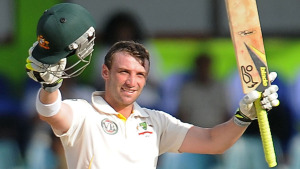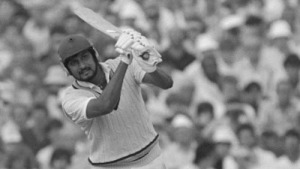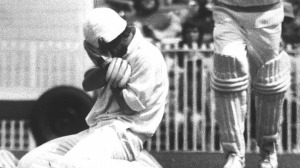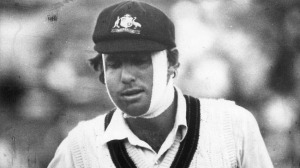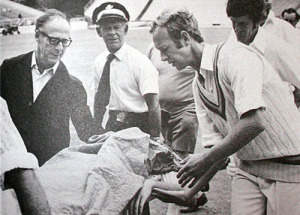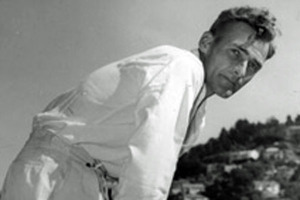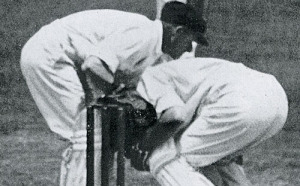Get well soon, Phil and think of Patil’s recovery
All our thoughts are on Phil Hughes who is fighting for his life at St Vincent’s hospital after being hit by a bouncer
By Kersi Meher-Homji
Like all cricket lovers I am praying for Phil Hughes’ recovery. When batting he was hit on his helmeted head by a bouncer in the Sheffield Shield match between South Australia and NSW at the Sydney Cricket Ground (SCG) on Tuesday. He is currently in an induced coma at St Vincent’s Hospital in Sydney, fighting for his life.
This shocking on-field accident took me back 33 years. It was also on the SCG, the first day of the first Test between Australia and India on 2 January 1981.
The Australian pace battery of Dennis Lillee, Len Pascoe and Rodney Hogg reduced India to a pathetic 5 for 78. The only batsman to offer some resistance was Sandeep Patil. He was going well at 65 when a bouncer from Pascoe hit him on his non-helmeted head and rendered him unconscious.
Sandip Patil
For a frightening few minutes he did not move a muscle and the spectators feared the worst. Carried to the hospital on a stretcher, gutsy Patil survived. He also batted in the second innings.
He went on to play an incandescent innings of 174 (including a six and 22 fours) three weeks later in the following Test in Adelaide. Till then it was the highest individual score by an Indian against Australia. It enabled India to draw the Test after they were thrashed by an innings in three days in Sydney.
So there is life and cricket after falling unconscious on a cricket pitch by a fast bouncing delivery.
History of cricket is full of batsmen carried on stretchers to hospitals who survived to score more runs.
Australia’s Graeme Watson was struck flush on the jaw by an accidental beamer from Tony Greig during a Rest of the World international in Melbourne in January 1972. The impact broke his nose and his clothing and pads were stained red. The damaged artery led to his requiring 20 litres of blood transfusions at St Vincent’s Hospital in Melbourne.
Australia’s Graeme Watson reels after being hit in the face by a beamer
He was on critical list for a week. Hospitalised for a month and advised by doctors not to play high level sport again, he was included in Western Australia’s XI a fortnight later. The following month he was named in Australia’s 1972 team to England.
In the Centenary Test against England, Australian opener Rick McCosker’s jaw was broken by speedster Bob Willis. Despite this, Rick came out to bat in the second innings at no.10, looking like an astronaut walking on space ”“ his jaw wired, face swollen and heavily bandaged. He batted for over an hour, adding 54 runs. As Australia won by 45 runs, this partnership was crucial.
Rick McCosker with bandaged jaw
Then there is the horrible experience of New Zealand fast-medium bowler Ewen Chatfield.
Ewen Chatfield being rushed to the hospital after he was struck on the temple by a fast ball
He had an unforgettable Test debut against England at Auckland in 1974-75 but for wrong reasons. After a stubborn innings at No. 11, he was struck on the temple by England’s fast bowler Peter Lever. Chatfield’s heart stopped beating and he swallowed his tongue. Only mouth-to-mouth resuscitation and heart massage by England’s physiotherapist Bernard Thomas saved his life.
Chatfield was rushed to hospital and regained consciousness an hour later. He was recalled in 1976-77, when he bowled steadily and industriously. Overshadowed by the legendary Richard Hadlee, he formed an effective an opening bowling partnership with him for a decade. Chatfield was awarded an MBE for his services to cricket.
Another New Zealander, the left-handed Bert Sutcliffe, lived after another on-field calamity.
Bert Sutclife was hit on the head by a bouncer
In the Johannesburg Test against South Africa in December 1953, Sutcliffe was hit on the head by a bouncer from Neil Adcock, the Transvaal terror. The crack was heard all over the ground and many thought he was dead. He fainted on his way to the hospital, bleeding profusely. With NZ at 6 for 82, he insisted on returning to the match. He scored a heroic 80 out of 106 in 112 minutes, hitting seven sixes, his second six saved a follow-on.
In the third Bodyline Test of February 1933, Australia’s wicket-keeper Bert Oldfield was knocked out with a fractured skull off England’s Harold Larwood’s bowling. So strong was the outrage that a telegram was sent to the MCC decrying the bowling as “unsportsmanlike”; and the MCC replied offering to cancel the remainder of the tour.
Bert Oldfield fractured his skull. Seen here as he bends over after being struck by Harold Larwood’s bowling
Oldfield missed the fourth Test but returned for the last Test in Sydney and scored 52.
Finally to the zenith of courage. During the tour of West Indies in 1962, India’s captain Nari Contractor received a near fatal injury from a quick short delivery from Charlie “Chucker” Griffith in the match against Barbados. Many of the players donated blood to save his life.
Nari Contractor helped off the ground by officials as he suffered a near fatal injury that ended his international cricketing career
Two operations were performed in the West Indies and one later in India when a steel plate was inserted on the injured skull. A few years later he played first-class matches but his Test career was cruelly aborted. He is alive 58 years later aged 80.
So Phil Hughes, as long as there is life, there is hope ”“ and runs. The cricketing world is praying for your recovery.
Short URL: https://indiandownunder.com.au/?p=4167

